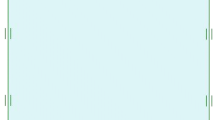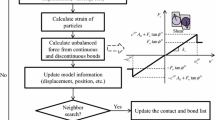Abstract
Tunnel excavation in weak surrounding rock areas is prone to landslide accidents, and the use of high-pressure rotary piles to pre-strengthen the soil in the local area can enhance the strength and bearing capacity of the surrounding rock. Discrete lattice spring model is established with the three-dimensional morphology modeling system of the rotary pile reinforcement. It is used to quantitatively characterize the reinforcement effects of high-pressure rotary piles, to analyze the influence of the reinforcement ratio and reinforcement function. The results show that compared with the deformation of unreinforced stratum, the high-pressure rotary pile can better control the ground surface settlement. The larger the reinforcement ratio is, the better the reinforcement effect of the rotary spray pile is, especially with the increase in reinforcement ratio, the contact between individual piles bites to form a row of piles, which can significantly improve the ability of the formation to resist deformation. Under the same reinforcement situation, the square root type reinforcement function has the best reinforcement effect, the line function has the middle reinforcement effect, and the quadratic type reinforcement function has the worst effect.










Similar content being viewed by others
Data availability
Data will be made available from the corresponding author by request.
References
Farmer W, Attewell PB (1964) Rock penetration by high velocity water jet: a review of the general problem and an experimental study. Int J Rock Mech Min Sci 2(1):135–153
Hsieh HS, Wang CC, Qu CY (2003) Use of jet grouting to limit diaphragm wall displacement of a deep excavation. J Geotech Geoenviron Eng 129(2):146–157
Wang K, Li Z, Zheng H et al (2021) A theoretical model for estimating the water-tightness of jet-grouted cut-off walls with geometric imperfections. Comput Geotech 138(6):104316
Wang X, Li J, Zhao X et al (2022) Propagation characteristics and prediction of blast-induced vibration on closely spaced rock tunnels. Tunn Undergr Space Technol 123:104416
Olgun M, Kanat A, Senkaya A, Erkan IH (2021) Investigating the properties of jet grouting columns with fine-grained cement and silica fume. Construct Build Mater 267:120637
Modoni G, Croce P, Mongiovi L (2008) Theoretical modelling of jet grouting. Geotechnique 58(6):533–535
Bui HH, Sako K, Fukagawa R (2007) Numerical simulation of soil–water interaction using smoothed particle hydrodynamics (SPH) method. J Terramech 44(5):339–346
Wang ZF, Shen SL, Ho CE, Kim YH (2013) Investigation of field installation effects of horizontal Twin-Jet grouting in Shanghai soft soil deposits. Can Geotech J 50(3):288–297
Shen SL, Wang ZF, Yang J, Ho CE (2013) Generalized approach for prediction of jet grout column diameter, J Geotech Geoenviron Eng ASCE. Accepted https://doi.org/10.1061/(ASCE)GT.1943-5606.0000932
Shen SL, Wang ZF, Cheng WC (2017) Estimation of lateral displacement induced by jet grouting in clayey soils. Géotechnique 67(7):621–630
Wang Z-F, Shen S-L, Modoni G, Zhou A (2020) Excess pore water pressure caused by the installation of jet grouting columns in clay. Comput Geotech 125:103667
Flora A, Modoni G, Lirer S, Croce P (2013) The diameter of single, double and triple fluid jet grouting columns: prediction method and field trial results. Géotechnique 63(11):934–945
Coulter S, Martin CD (2006) Single fluid jet-grout strength and deformation properties. Tunn Undergr Space Technol 21(6):690–695
Croce P, Flora A (2000) Analysis of single-fluid jet grouting. Géotechnique 50(6):739–748
Lignola GP, Flora A, Manfredi G (2008) Simple method for the design of jet grouted umbrellas in tunnelling. J Geotech Geoenviron Engineering 134(12):1778–1790
Zhao CY, Lei MF, Shi CH et al (2021) Function mechanism and analytical method of a double layer pre-support system for tunnel underneath passing a large-scale underground pipe gallery in water-rich sandy strata: a case study. Tunn Undergr Space Technol 115:1–14
Nikbakhtan B, Osanloo M (2009) Effect of grout pressure and grout flow on soil physical and mechanical properties in jet grouting operations. Int J Rock Mech Min Sci 46(3):498–505
Zhao G-F, Fang J, Zhao J (2011) A 3D distinct lattice spring model for elasticity and dynamic failure. Int J Numer Anal Methods Geomech 35(8):859–885
Zhao GF, Wei XD, Liu F et al (2020) Non-parameterized numerical analysis using the distinct lattice spring model by implementing the duncan-chang model. Rock Mech Rock Eng 53(4):2365–2380
Zhao G-F (2015) Modelling 3D jointed rock masses using a lattice spring model. Int J Rock Mech Min Sci 78:79–90
Zhao GF, Lian J, Russell A et al (2019) Implementation of a modified Drucker–Prager model in the lattice spring model for plasticity and fracture. Comput Geotech 107:97–109
Acknowledgements
This paper is supported by the Postdoctoral funding program (2023-61-JTY). The financial aid is gratefully acknowledged.
Author information
Authors and Affiliations
Corresponding author
Ethics declarations
Conflicts of interest
The authors declare that there are no conflicts of interest regarding the publication of this paper.
Additional information
Publisher's Note
Springer Nature remains neutral with regard to jurisdictional claims in published maps and institutional affiliations.
Rights and permissions
Springer Nature or its licensor (e.g. a society or other partner) holds exclusive rights to this article under a publishing agreement with the author(s) or other rightsholder(s); author self-archiving of the accepted manuscript version of this article is solely governed by the terms of such publishing agreement and applicable law.
About this article
Cite this article
Chen, X., Zhu, X., Xu, H. et al. Deformation features of high-pressure rotary pile reinforced strata by discrete lattice spring modeling (DLSM). Comp. Part. Mech. (2024). https://doi.org/10.1007/s40571-024-00733-y
Received:
Revised:
Accepted:
Published:
DOI: https://doi.org/10.1007/s40571-024-00733-y




